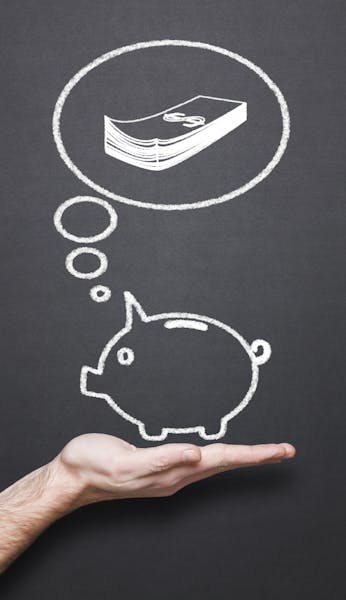Many Americans know they don't save enough.
Only half of us have good savings habits and think we're prepared for our financial future, according to a 2013 survey by Consumer Federation of America (CFA). In President Obama's recent State of the Union address, he proposed "myRA" accounts, another plea for us to save more for retirement.
Sen. Tom Harkin, D-Iowa, believes that Americans are about $6.6 trillion short of funding a secure retirement. While numbers starting with a "T" are startling, the answer to solving a big money problem like retirement savings lies in solving a much smaller problem first: getting us to succeed at smaller goals.
In other words, if saving $500,000 or more for retirement seems unfathomable, start with saving $50 a month just to say you can do it, or $500 so you'll be able to replace an aging transmission.
It's a compelling reason for consumers to visit a local bank or credit union. Unfortunately, interest rates below 1 percent fail to excite anyone. But consumers wanting a more lucrative jolt can find $50 to $250 bonuses for opening a new account.
The bad news? They're usually for opening a checking account or a credit card, not savings. "Savings accounts are not one of the more profitable products by banks," said George Barany, director of financial education at CFA. "Banks can make more money on checking accounts and credit cards because there's a much higher likelihood of incurring a fee."
In fact seven of the nine bonuses of $50 to $250 in this month's post of top bank account promotions at Moneycrashers.com are for checking accounts. Only one of the incentives is for a savings plan — U.S. Bank's Savings Today and Rewards Tomorrow program, known as S.T.A.R.T.
U.S. Bank customers who save $1,000 in S.T.A.R.T. earn a $50 Visa rewards card initially and an extra $50 when $1,000 or more is left in the account for one year. With the $100 reward, consumers are earning 10 percent annual interest, an excellent rate compared with going rates near 1 percent.
Small savers can take longer than a year to accumulate $1,000, but they need to maintain a balance of $1,000 or more for a year to get the second $50.
Barany said that U.S. Bank is to be commended for its S.T.A.R.T. program, which has gotten more than 2 million customers saving since its introduction in 2010. "Having a savings incentive program is unusual," he said. "Banks usually offer a slightly higher interest rate but no long-term sustained product."
Last month, the program had more than $4 billion in savings, said Karen Johanning, the S.T.A.R.T. expert at U.S. Bank. On its Facebook page, the bank asked readers to post their own experiences of saving for something memorable. The more than 500 responses included vacations, a new roof and a new washer and dryer.
Hannah Hyatt of southern Illinois wrote: "We encouraged our daughter to open a savings account and she saved enough to buy herself a Diamondback mountain bike. She's 7, so I consider that quite an accomplishment!"
The S.T.A.R.T. program, like almost any bank offering, is not without potential gotchas. It requires a checking account in tandem with the savings account. And there are monthly maintenance fees of $7 to $9 per month, unless an account holder has a combined account balance of $1,500 in savings and checking or direct deposits of $1,000 per month. While many adults might be able to meet the minimum, small savers would quickly lose money.
Banks seldom offer good incentives on savings accounts because they aren't "sticky" enough, said Greg McBride, a senior financial analyst with Bankrate.com in North Palm Beach, Fla. "Consumers close savings accounts more often than checking accounts," he said. "With checking accounts they might add credit or debit cards and online bill pay, and that makes them less likely to flee to a competitor."
Besides that, banks are swimming in deposits right now and loan demand is off. That means they don't need to pay incentives, McBride said.
Other than U.S. Bank, I couldn't find any local banks or credit unions offering incentives of $50 or more for opening a savings account, but banks have found creative ways to get people to save.
For example, Wells Fargo and other banks offer a form of "forced" savings, including automatic monthly transfers from their checking to savings accounts. The consumer may also be able to authorize the bank to take out an additional $1 for each debit card purchase, online bill pay or automatic payment and transfer it to their savings account. At Wells Fargo the automatic savings option, called Save As You Go, waives the $5 monthly service fee, spokeswoman Peggy Gunn said.
An extra dollar here and there may not provide the rush that an extra $100 might, but Minneapolis resident Nathan Dungan, founder of Sharesavespend.com, said it works. "People quickly get comfortable with these auto deductions," he said. "How many times do we swipe a debit card in a day? It's almost like getting free money."
John Ewoldt • 612-673-7633
